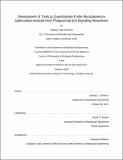Development of Tools to Quantitatively Probe Mycobacterium tuberculosis-induced Host Phagosomal and Signaling Responses
Author(s)
Solomon, Sydney Leigh
DownloadThesis PDF (3.144Mb)
Advisor
Bryson, Bryan D.
Terms of use
Metadata
Show full item recordAbstract
Globally, tuberculosis (TB) remains a leading cause of infectious death, second only to COVID-19 in 2021. With over ten million new infections occurring every year, there remains an urgent need for an improved vaccine to reduce transmission and protect against TB complications. Additionally, the growing prevalence of multi-drug resistant strains of Mycobacterium tuberculosis (Mtb) necessitates new modalities for host state modulation to promote bacterial clearance. During infection with Mtb, host macrophages engulf the bacteria and sequester them in the phagosome. This interaction involves the recognition of Mtb by pattern recognition receptors (PRRs) leading to downstream signaling and cytokine production. While there are several hypotheses about how an infected cell controls Mtb, specific mechanisms have yet to fully explain how phagosomal composition and immune activation during infection influence Mtb clearance. Current methods to assess these areas of study lack specificity and application to live, virulent Mtb infection.
This thesis develops and extends new tools to assess host-cell state during infection with Mtb. First, I sought to decipher the composition of the Mtb-containing phagosome through pathogen-mediated proximity labeling. This led to the development of three strategies for chemically conjugating heterologous proteins and enzymes. Future work will apply these strategies to functionalize the surface of Mtb with proximity ligases to identify the host proteins directly interacting with the bacteria. Next, I investigated the relationship between Mtb activation of PRRs and bacterial clearance. I utilized high-resolution single-cell approaches to measure signal activation via pathway phosphorylation and cytokine production in both directly Mtb-infected and bystander macrophages. Through modulation of these pathways, I decoupled inflammatory and antimicrobial capacity, leading to the hypothesis that productive antimicrobial responses require another signal in addition to PRR activation and phagocytosis. Collectively, this work contributes new tools vital for the identification of desirable host-cell states to promote the design of new vaccine correlates of protection and host-directed interventions.
Date issued
2023-02Department
Massachusetts Institute of Technology. Department of Biological EngineeringPublisher
Massachusetts Institute of Technology